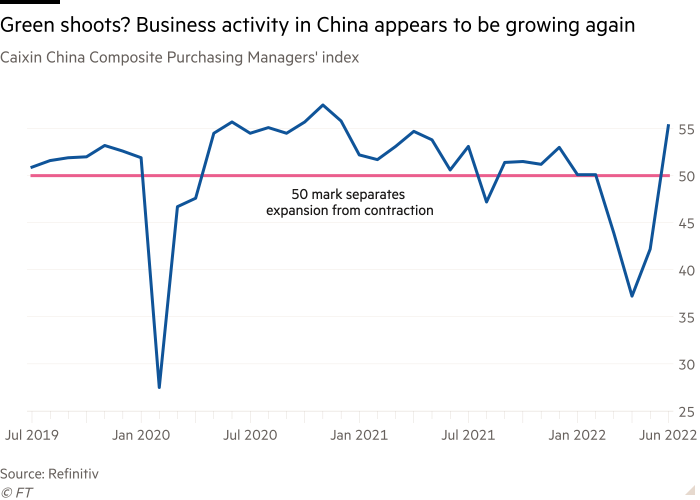China’s contrasting path offers the potential for uncorrelated returns

Roula Khalaf, Editor of the FT, selects her favourite stories in this weekly newsletter.
The writer is chief investment officer at Bank of Singapore
Like it or not, China is different. The populous nation resides in an alternate universe where Covid-19 restrictions prevail and economic activity strains at the gates for gradual reopening.
But while global equity markets are suffering their worst first half-year start since 1970, Chinese stocks may be the one major market to offer uncorrelated positive returns in the second half of 2022.
Since mid-2021, Chinese markets have borne the brunt of selling well before the global bear market malaise in the first half of 2022. China has suffered four quarters of sliding or relatively weak growth, souring market sentiment in both equities and bonds.
On top of China’s stringent zero-Covid lockdown, the broad swath of woes have included credit growth constraints, supply chain tightness, semiconductor shortages and adverse regulatory scrutiny across industries such as property, technology, education and gaming. There have also been uncertainties surrounding the regulations for US-listed China American Depositary Receipts, instruments that offer US investors exposure to foreign stocks.
Over the past few months, the outlook has begun to brighten. Significantly, April’s Politburo meeting marked a change of tone from officials and the start of supportive policies. The benchmark five-year Loan Prime Rate was cut. Some 33 comprehensive stimulus measures were announced by the State Council.
Regulators have also clarified their stance for tech platform companies and gaming approvals. President Xi Jinping reiterated commitment to the official 5.5 per cent GDP growth target for 2022 last month, and, importantly, the quarantine period for inbound travellers has been halved as the authorities begin to loosen its zero-Covid stance.
The green shoots of recovery are apparent in June’s data releases. The Caixin composite purchasing manager Index jumped more than 13 points to 55.3 points, implying activity is expanding firmly again as lockdowns ease.

Unlike global peers, inflation woes are not top of mind in China. Officials face benign 2.5 per cent inflation, food and energy resilience, a current account surplus and ample room for fiscal and monetary stimulus to meet this year’s official GDP target.
The People’s Bank of China stands out as the only central bank under no pressure to hike interest rates to curb inflation. Its capital controls also keep the renminbi stable despite the strength of the dollar. In fact, China can afford to lower interest rates to ease credit conditions.
Despite the recent bounce from April’s lows, the CSI 300 Index and the broader MSCI China Index still trade at 13 and 12 times forward price-to-earnings ratios respectively, close to their historic averages. Recent funds flow data show that emerging markets fund managers have closed their underweight position in China relative to benchmarks in the past six months.
But we’re not out of the woods. The overhang for China remains its zero-Covid policy, which is likely to continue at least until the 20th Party Congress in the fourth quarter. The PBoC’s second-quarter survey of bankers and enterprises suggests that loan demand and business conditions remain weak.
China high-yield bonds, dominated by real estate issues, are down 30 per cent year-to-date, trading at distressed levels. Despite the nascent recovery of property sales and share prices, the offshore property bond remains moribund.
US-China relations also remain a structural risk. President Joe Biden is still weighing whether to extend Trump-era tariffs on Chinese imports into the US. Furthermore, audit disputes over US-listed China firms remain in the balance.
Despite investors’ chagrin at the ebbs and flows in China’s investor friendliness, we are witnessing the first innings in the internationalisation of China’s onshore capital markets across currency, stocks and bonds.
China’s energy transition and technological advances offer investment opportunities in green infrastructure, while national focus on “common prosperity” supports consumer companies serving the rising middle class.
Notwithstanding the regulatory and geopolitical risks, China’s unique value proposition for global investors lies in its contrasting fortunes within the global economic world order — relative to developed nations and broader emerging markets. There will be an opportunity cost for global investors of not owning China. This is a set up to make staunch bears reluctant bulls.
Comments